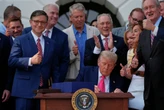YouTube is giving some creators previously banned for spreading misinformation a chance to get back on the platform. The company opened up a pilot program on Thursday inviting YouTubers who were kicked off of the video sharing site under now-outdated rules to apply for a new channel.
The company announced the second chance process last month, describing it as a “limited pilot project” for some creators, including those with channels banned under policies the platform has since abandoned. YouTube’s announcement came the same day that the company issued a conciliatory letter to Republican Rep. Jim Jordan, who has pressured YouTube and other social media companies for years over unfounded claims that they deliberately censor conservative viewpoints.
We've had a lot of questions about a pathway back to YouTube for some terminated creators to set up a new channel. This will be a limited pilot project that will be available to a subset of creators in addition to those channels terminated for policies that have been deprecated.…— Updates From YouTube (@UpdatesFromYT) September 23, 2025
We've had a lot of questions about a pathway back to YouTube for some terminated creators to set up a new channel. This will be a limited pilot project that will be available to a subset of creators in addition to those channels terminated for policies that have been deprecated.…
YouTube’s changing rules
Not all creators given the boot will be eligible for a second chance. YouTube notes that some types of channel terminations will stand, including bans for copyright infringement and for violations of its policies against abuse and violence off-platform. Channels eligible to be reinstated will see an option to request a fresh channel on YouTube Studio over the next few weeks, according to the company.
“We’re looking forward to providing an opportunity for creators to start fresh and bring their voice back to the platform,” the company wrote in a blog post. “As always, our Community Guidelines and other policies still apply to help us maintain a responsible business that viewers, creators, and advertisers rely on.”
If approved, creators previously banned from YouTube will be allowed to create a new channel from scratch – not resurrect the channel that earned them the ban. While YouTube describes the program as a “fresh start,” creators will be allowed to re-upload old videos that don’t violate the platform’s policies in 2025. Once a new channel becomes eligible, previously banned creators won’t face any restrictions on monetization.
The pilot program applies to channels that have been offline for at least a year. For channels banned more recently, YouTube points creators to its existing appeals process. Creators that successfully appeal a ban can have their channels reinstated rather than going through the new pilot program.
For social media companies, policies follow politics
YouTube, like other social networks, has dismantled some content moderation policies in recent years. After building out a framework to limit the spread of misinformation during the Biden era, including rules punishing channels for election denialism after Jan. 6, YouTube is now backing away from many of those policies. The company said that it opted to sunset election misinformation rules to allow for discussion of “possible widespread fraud, errors, or glitches occurring in the 2020 and other past U.S. presidential elections.”
Since 2023, YouTube has also rolled back rules specific to Covid-19 and vaccine-related misinformation, a fact the company highlights in the letter sent last month to Jordan. “YouTube continues to enable a diversity of perspectives and believes creators should be able to openly debate political ideas on the platform,” the company wrote in the letter. The community guidelines “allow for a wider range of content” on those topics now, according to YouTube.
“YouTube values conservative voices on its platform and recognized that these creators have extensive reach and play an important role in civic discourse,” YouTube wrote in the letter. “The Company recognizes that these creators are among those shaping today’s online consumption, landing “must-watch” interviews, giving viewers the chance to hear directly from politicians, celebrities, business leaders, and more.”
Regulatory threats set the tone
The decision to invite once-banned creators back comes as YouTube seeks to put itself in the good graces of President Trump and likeminded Republicans in Congress. In his second term, the Trump administration has been eager to reward loyalists and punish its perceived political enemies. Trump has already wielded threats from the FCC against broadcast networks airing critical content, but other agencies like the DOJ and FTC could also be aimed at the administration’s critics.
Just last week, YouTube agreed to pay $24.5 million to settle a lawsuit Trump filed in 2021 after breaking its rules against inciting violence during the Jan. 6 attack on the U.S. Capitol. Meta and X, formerly Twitter, also paid $25 million and $10 million respectively to settle parallel lawsuits from Trump after the former president again took office. None of the cases were regarded as particularly credible by legal experts, nor was another lawsuit against Paramount, which the company opted to settle in July for $16 million, paving the way for FCC approval of its lucrative merger.









No comments